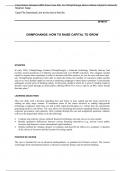i1v2e5y5pubsW19197
CHIMPCHANGE: HOW TO RAISE CAPITAL TO GRO W
.
,
; .
.
,
SYNOPSIS
In early 2016, ChimpChange Limited (ChimpChange), a financial technology (fintech) start -up, had
recently started operations in California and already had over 80,000 customers. The company needed
capital to acquire more customers in order to become cash -flow positive, as was the case with most start
ups. ChimpChange should have been able to attain the break -even number of customers within another
year or so, but it needed capital to execute a marketing campaign to attract these customers. It had already
undergone several series of funding rounds. At this point, should it return for a series C funding round or
should it raise funds through an initial public offering (IPO)? If it were to opt for an IPO, where should
this take place?
LEARNING OBJECTIVES
This case deals with a decision regarding how and where to raise capital and the issues involved in
valuing an early stage venture. It introduces some of the issues involved in valuing high -growth
technology companies while they are still in their rapid growth phase (i.e., before they are consistently
generating positiv e cash flows). The case allows for interesting discussions regarding fintech, disruption,
corporate governance, and valuation. After working through the case and assignment questions, students
will have developed their ability to do the following:
• Compare and contrast various methods financial technology start- ups can use to raise capital.
• Identify qualitative differences between various financing alternatives (e.g., private versus public
investors and domestic versus international capital markets).
• Outlin e methods for valuing a project or company, and describe the effects on a company’s valuation
of the choice of investors and the location for raising capital.
POSITION IN COURSE
The case is intended for use in advanced undergraduate -or graduate -level finance courses. The courses
could range from international finance to advanced corporate finance and investment banking.
This Teaching Note is authorized for use only by ELENA PIKULINA, University of British Columbia until Feb 2024. Copying or posting is an infringement of copyright.
Permissions@hbsp.harvard.edu or 617.783.7860.Case Notes /Answers With Free Case File for ChimpChange How to Raise Capital to Grow By
Stephen Sapp
Case File Download Link at the end of this file.
1 / 2
Page 2 8B19N009
RELEVANT READINGS
• Michael King, “Preparing Canada for the Fintech Tsunami,” Ivey Business Journal , January/February
2018, accessed March 7, 2019, https://iveybusinessjournal.com/preparing -canada -for-the- fintech -
tsunami.
• “How to Value an Early -Stage FinTech Company” Mercer Capital, August 2018 , accessed March 7,
2019, https://mercercapital.com/assets/Mercer -Capital_How- to-Value- an-Early-Stage -FinTech -
20181.pdf
• David Ehrenberg, “The Most Common Funding Types for Young Startups, Explained,” Yahoo Small
Business, accessed March 7, 2019, https://smallbusiness.yahoo.com/advisor/blogs/young -
entrepreneurs/most -common -funding- types -young- startups-explained-180127980.html
TEACHING PLAN
This case is suitable for use in an 80 -minute class session, as outlined below:
• Describe the current situation facing ChimpChange. (5 minutes)
• Explain why ChimpChange currently needs to raise money. How much money does it need? (5
minutes)
• Identify the different ways the company can raise the capital. How do these ways relate to the
preferences of Shilkin and the other stakeholders? This answer can include a discussion of terms such
as angel investor, seed cap ital, venture capital, and series A, B, and C funding. (10 minutes)
• Size up the market and evaluate the future prospects for ChimpChange in this industry. (10 minutes)
• Discuss the different methods of valuing high -growth technology companies. (5 minutes)
• Perform a comparable valuation based on the number of users. Consider recent transactions and
market comparables for firms being traded in Australia and the United States without a control
premium, which may be in the recent transactions. (15 minutes)
• Depen ding on the goals of the case discussion, a discounted cash flow (DCF) valuation can be
performed using forecasts of the cash flows. Use the income statement, and assume a growth in
margins as the revenues increase at a faster rate than costs. Assume most costs are fixed, but not all,
and a growth rate as per projections from the marketing plan. (15 minutes)
• Discuss how the valuation may change depending on the investors (venture capital/private equity or
IPO/public equity) and location (domestic or interna tional markets), and discuss how this may affect
investors’ decisions. (10 minutes)
• Discuss the decision and what happened next. (5 minutes)
ASSIGNMENT QUESTIONS
1. What are the opportunities and threats for ChimpChange’s success going forward?
2. What alternatives exist for ChimpChange to raise capital to accomplish its strategic goals?
3. What questions would investors ask before investing in this company? How could they get answers to
these questions?
4. How much do you think ChimpChange is currently worth? In addition to any other valuation methods
you think appropriate, perform a DCF valuation based on the information in case Exhibit 8, carefully
considering all of your assumptions in base case, best case, and worst case scenarios. Whic h valuation
method(s) do you think are most applicable to ChimpChange?
5. Would the valuation depend on the way the company raises capital? Please support your answer.
This Teaching Note is authorized for use only by ELENA PIKULINA, University of British Columbia until Feb 2024. Copying or posting is an infringement of copyright.
Permissions@hbsp.harvard.edu or 617.783.7860.Powered by TCPDF (www.tcpdf.org)
2 / 2




